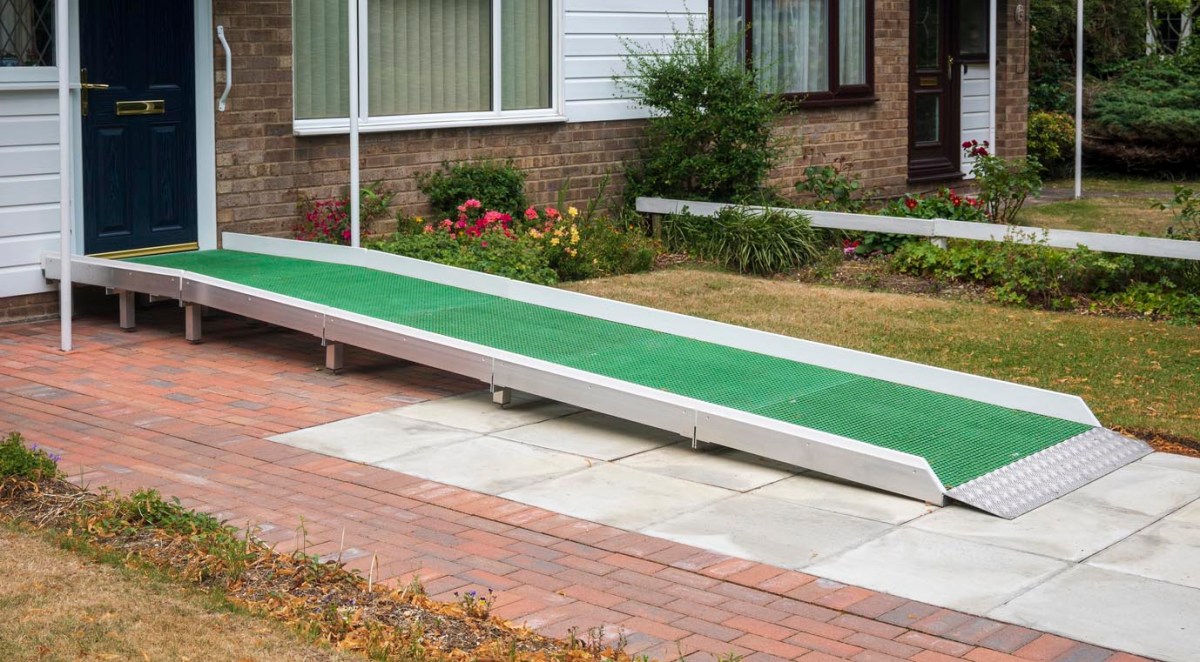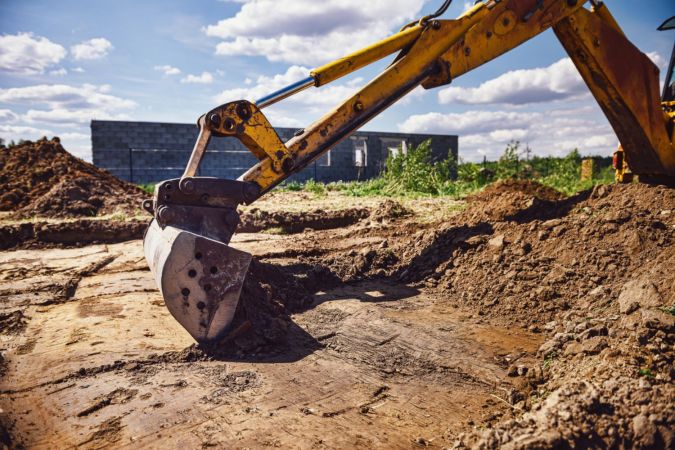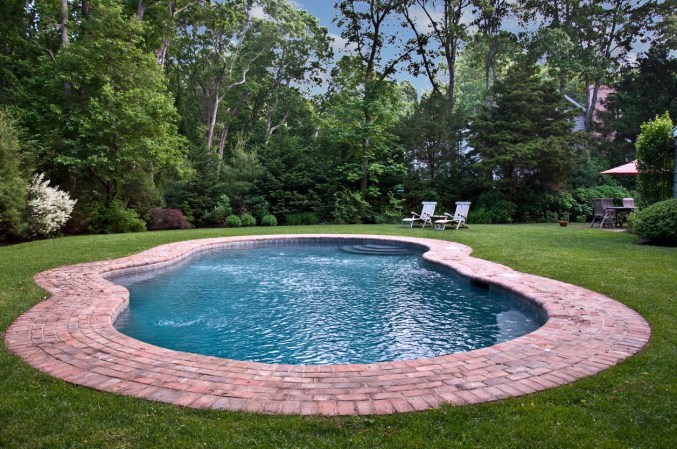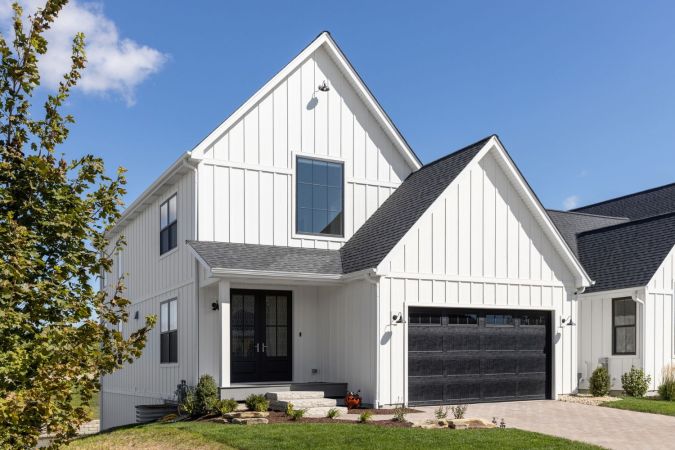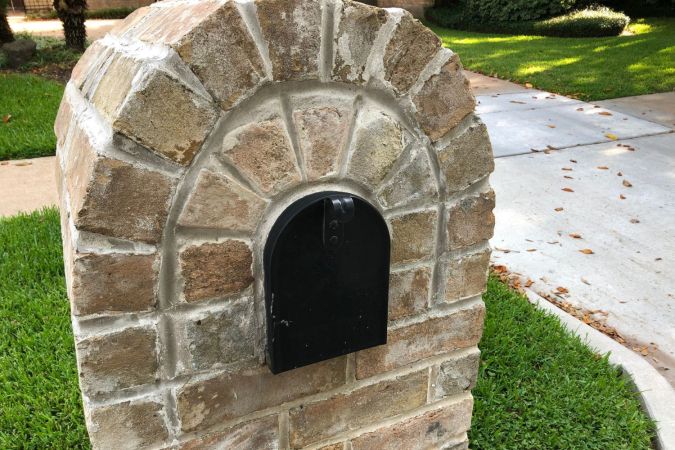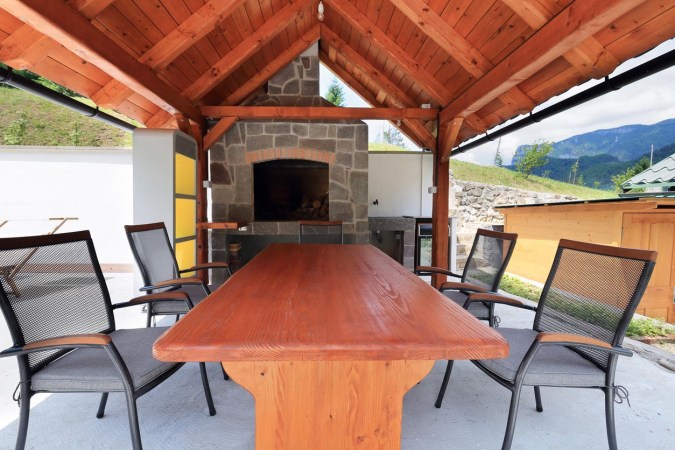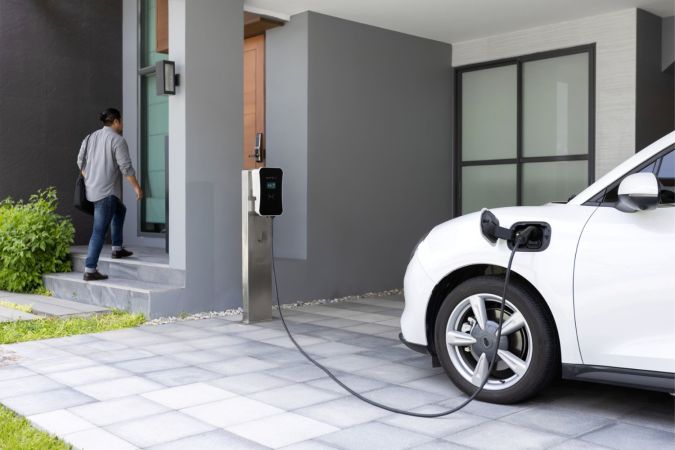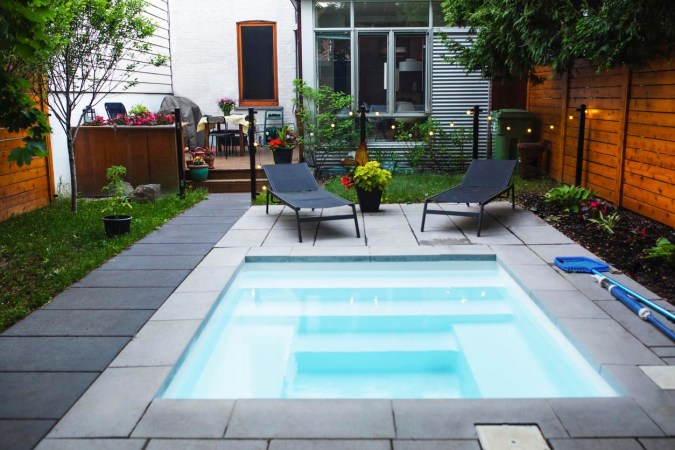We may earn revenue from the products available on this page and participate in affiliate programs. Learn More ›
Highlights
- The typical cost range to build a wheelchair ramp is $1,031 to $3,313, with a national average cost of $2,170.
- The main factors that influence wheelchair ramp installation costs include the ramp size and material, the type of ramp, the weight specifications, the cost of labor, and the installation location.
- Some of the main benefits of wheelchair ramp installation include better accessibility and independence for wheelchair users, improved privacy, and added safety.
- Wheelchair ramps are required to follow ADA (Americans with Disabilities Act) guidelines, which means it’s best to leave this project to an experienced professional to ensure it checks all the boxes.
The home is where people return after a long day at work, a busy night out, or an enjoyable brunch with friends. It’s a place that is intended to convey safety, security, and comfort, so it is imperative that the home be accessible to guests, residents, and homeowners. However, many homes have stairs leading up to the main entrance or a steep lip on the doorway that makes it difficult for wheelchair users to enter or exit. Adding a wheelchair ramp is an easy way to make a home more accessible and comfortable for resident or guest wheelchair users.
Wheelchair ramps for homes are incredibly important for the independence, privacy, and safety of wheelchair-using residents. According to Angi and HomeAdvisor, building a wheelchair ramp will typically cost $1,031 to $3,313, or about $2,170 on average, depending on the type of wheelchair-accessible ramp. Additionally, the cost of this project will differ based on the location of the ramp. Outdoor wheelchair ramps are generally more expensive to build than indoor wheelchair ramps. Homeowners can use this guide to find out more about the various factors that can impact wheelchair ramp cost.
Factors in Calculating Wheelchair Ramp Cost
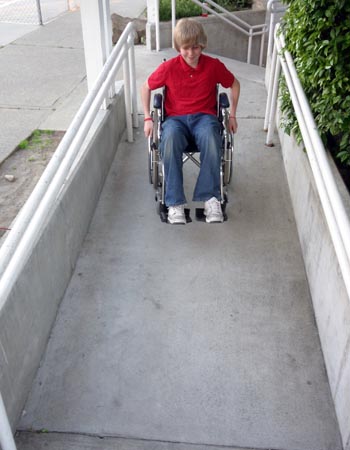
Homeowners will want to take some time to research wheelchair ramp cost considerations before attempting to put together a budget. They’ll want to make sure that the budget covers all primary and additional cost factors for the wheelchair ramp installation project to avoid any unexpected fees or delays with the work. Among the various factors that can affect wheelchair ramp cost are the ramp size, material, and type; weight specifications; labor costs; and the installation location.
Ramp Size
One of the first factors to figure out is how big the ramp will need to be. Generally, the steeper the incline, the larger the ramp will need to be to provide adequate assistance to those getting into the home. Similarly, the longer the ramp, the more it will cost. Homeowners will want to be prepared to spend about $50 to $250 per linear foot for wheelchair ramp installation.
Homeowners are advised to keep in mind that the Americans with Disabilities Act (ADA) mandates that ramps not rise more than 1 inch in height for every foot in length. The ADA further notes that the wheelchair ramp must stand at a minimum of 36 inches wide by 60 inches long, though many ramp designs will need to be wider and longer than this minimum standard. Once a basic plan has been put together, homeowners can use a wheelchair ramp cost calculator to help estimate the total cost.
Ramp Material
After coming up with a basic layout for the ramp, the homeowner and contractor will need to decide on the type of material that will be used to build the wheelchair-accessible ramp. Common options include aluminum, composite, concrete, prefabricated aluminum, rubber, steel, and wood.
| Ramp Material | Average Cost per Linear Foot (Materials and Labor) |
| Aluminum | $150 to $200 |
| Composite | $150 to $200 |
| Concrete | $200 to $250 |
| Prefabricated aluminum | $100 to $150 |
| Rubber | $50 to $150 |
| Steel | $200 to $250 |
| Wood | $100 to $250 |
- Aluminum wheelchair ramps are a popular choice due to their average cost, lightweight construction, and corrosion resistance. Homeowners can expect to pay about $150 to $200 per linear foot for an aluminum wheelchair ramp installation.
- Composite wheelchair ramps are lightweight and highly resistant to rust, corrosion, warping, and insect damage. This material costs about $150 to $200 per linear foot, making it a great choice for those who need a long-lasting ramp material but don’t want to pay for a concrete or steel ramp.
- Concrete wheelchair ramps are a top choice for permanent wheelchair ramp installations due to their high level of durability and resistance and their long life. Homeowners will pay about $200 to $250 per linear foot. This higher cost is generally associated with the additional time and effort involved in the installation process.
- Prefabricated aluminum wheelchair ramps come in prebuilt sections that just need to be assembled. This type of ramp material costs about $100 to $150 per linear foot, though the materials may have a long manufacturing and shipping period.
- Rubber wheelchair ramps are one of the more affordable choices at just $50 to $150 per linear foot. However, this material option is really useful only for a small wheelchair ramp or a temporary threshold ramp.
- Steel wheelchair ramps cost about $200 to $250 per linear foot. Despite this high price, steel is one of the best options for durability, though the metal is vulnerable to rusting and corrosion over time. Also, it’s important that the ramp have a textured surface to reduce the risk of slipping.
- Wood wheelchair ramps cost about $100 to $250 per linear foot. Wooden wheelchair ramp construction is a viable choice as long as there is someone with the skills to keep up with regular maintenance, like sanding, staining, painting, and adding an anti-slip finish.
Ramp Type
The next factor for homeowners to consider is the type of ramp. There are several options to choose from depending on the size of the ramp, the location, and the length of time the ramp is required. Mini ramps and threshold ramps are the least expensive options, though they are generally useful only for single-stair entrances. Modular ramps come in prebuilt pieces that can be assembled on-site.
Portable ramps are a good choice for RVs, vans, trucks, and other vehicles, but they can also be used temporarily for entrance and exit into a home. Homeowners can invest in a permanent ramp if they own the property, while renters are better off installing a semi-permanent ramp that functions like a permanent ramp but can be removed without damaging the property. Homeowners will want to carefully consider the accessibility needs, ramp size, ramp location, and installation duration before deciding on a ramp type.
Weight Specifications
Another factor that can impact the overall cost of the renovation project is the weight requirements or specifications for the ramp. Light-duty ramps don’t require a lot of material or support structures, which reduces the cost to manufacture, transport, and install the ramp. However, the drawback is that these ramps cannot support as much weight without bending, warping, or buckling.
Homeowners will want to consider the weight of the assistance device when deciding on the size and type of wheelchair ramp. A standard manual wheelchair typically weighs less than a motorized wheelchair, though the motorized wheelchair, in turn, weighs significantly less than a full-size electric scooter. It’s crucial for homeowners to ensure that the ramp fits all necessary weight specifications for safety purposes.
Labor
Installing a wheelchair-accessible ramp for the home is not typically a project that a DIYer would tackle due to the potential risks involved if there was a problem with the construction. With this in mind, it’s important for homeowners to make room in their budget to account for the cost of labor. Professional labor for a wheelchair ramp installation ranges from about $35 to $100 per hour, though this rate can fluctuate depending on the geographic location of the project.
Due to supply and demand, homeowners in rural areas will generally pay less for wheelchair ramp installation than those located in dense urban areas. Additionally, the labor rate can increase or decrease based on the material and type of ramp. For instance, it usually costs less for a carpenter to put in a custom wood ramp than it does to have a masonry contractor build a concrete ramp.
Installation Location
Making the home more accessible is an important step in creating a comfortable and secure house. The location of the ramp will make a significant difference in the overall cost of the job.
- Outdoor wheelchair ramps tend to cost more than indoor ramps. This is generally attributed to the need for weather-resistant materials that are both durable and long-lasting for outdoor installations. Homeowners who are building an outdoor wheelchair ramp can plan on spending about $1,200 to $5,000 to complete the work.
- Indoor ramps are typically smaller than outdoor ramps and may even have a light-duty portable design that reduces the amount of time it takes to manufacture and install them. Homeowners can expect a more affordable price for an indoor ramp installation, ranging from just $200 to $2,000.
Additional Costs and Considerations
Beyond the primary cost factors, there are several additional costs that could impact the budget for the project. Before finalizing the project plan, homeowners will want to consider whether the job will require handrails, additional landings, or any extra features. They can speak to the installer to determine the wheelchair ramp removal cost and to find out if permits are necessary. It’s also a good idea for homeowners to consider whether a permanent ramp is the best option or if a rented ramp will fulfill short-term needs.
Additional Landings
Small wheelchair ramps are generally the least expensive because there is less material and time spent building the ramp. However, not all buildings are designed for a small wheelchair ramp. The more stairs and the steeper the incline, the longer and larger the ramp will need to be to provide adequate access to the property.
According to the ADA, there must be a landing positioned at least once every 30 linear feet or every 30 inches of rise. Adding these extra landings will increase the cost of the materials and the time spent building the ramp, which leads to higher labor costs for the project. In some cases, it may be more cost-effective to abandon the ramp project and invest in stair lift cost instead.
Handrails
Wheelchair ramps that rise more than 6 inches from the ground require a handrail to meet ADA compliance standards. When homeowners are putting together the budget for a wheelchair ramp installation project, it’s important for them to note that handrails are not often included in the initial cost of the job.
Installing handrails typically costs an additional $80 per linear foot, so homeowners are advised to have a little extra room in the budget to account for this feature. They can speak to the contractor before starting the project to determine if the handrails are required and to find out if the cost of the handrail installation is included in the initial estimate for the project.
Permits
Temporary, portable, threshold, mini, and even some semi-permanent wheelchair ramps can be installed without the need for a permit. Generally, a building permit is required for permanent, some semi-permanent, and some custom wheelchair ramp installation projects, though this varies depending on local laws and regulations.
Homeowners will want to speak to their permit office or discuss the permit requirements with their contractor to determine if a permit will be needed for this specific job. If a permit is required, homeowners can plan on spending about $30 to $120 to get a building permit for the project. Some contractors may take care of this process, though it’s a good idea for the homeowner to ask the contractor ahead of time to ensure that they will get a permit before work begins.
Additional Features
Another cost factor for homeowners to consider when planning a wheelchair ramp installation project is whether the home requires any additional features to meet the standards set out by the ADA. Some common additions include installing a stair life, widening doors, putting in lower counters, and equipping the wheelchair ramp with walkway lighting.
Depending on the upgrade, the wheelchair ramp installation company may have trained contractors with experience installing or setting up various assistance and accessibility features, so it’s a good idea for the homeowner to discuss any potential extras before starting the project.
| Feature | Average Cost (Materials and Labor) |
| Countertop lowering | $1,900 to $4,400 |
| Door widening | $300 to $2,500 per door |
| Indoor stair lift installation | $2,000 to $20,000 |
| Wheelchair ramp lighting | $15 to $100 per light |
Existing Ramp Removal
When an existing ramp is in poor condition, it can put users at risk, so it’s important for homeowners to repair and regularly maintain the ramp to keep it functional. However, there is a limit to the number of repairs and patches that can be applied. Before hitting that limit, homeowners are advised to replace the existing ramp with a new wheelchair ramp that meets ADA standards.
Depending on the type of wheelchair ramp and the material used to make it, the installers may be able to remove and dispose of the structure before installing a new wheelchair ramp. In some cases, the homeowner will need to hire a separate contractor to demolish and remove the existing ramp, such as in the case of an old concrete ramp. Homeowners will want to be prepared to spend between $550 and $1,650 to demolish, deconstruct, and remove the existing wheelchair ramp.
Buying vs. Renting
Not every situation requires the purchase of a new wheelchair ramp. For instance, if the goal is to improve accessibility during a road trip, then renting a portable RV wheelchair ramp is a good option.
- Buying a wheelchair ramp is often the right choice when a wheelchair user lives at the house or visits often. This project costs between $1,031 and $3,313, but it is worth the investment to ensure the independence, privacy, and safety of the homeowner, residents, and guests.
- Renting a wheelchair ramp can be a good way to provide wheelchair access to the home or to a vehicle for a short period of time. Generally, wheelchair ramp rental will cost about $100 to $280 per month, and it will often have a onetime installation fee that falls between $300 to $800.
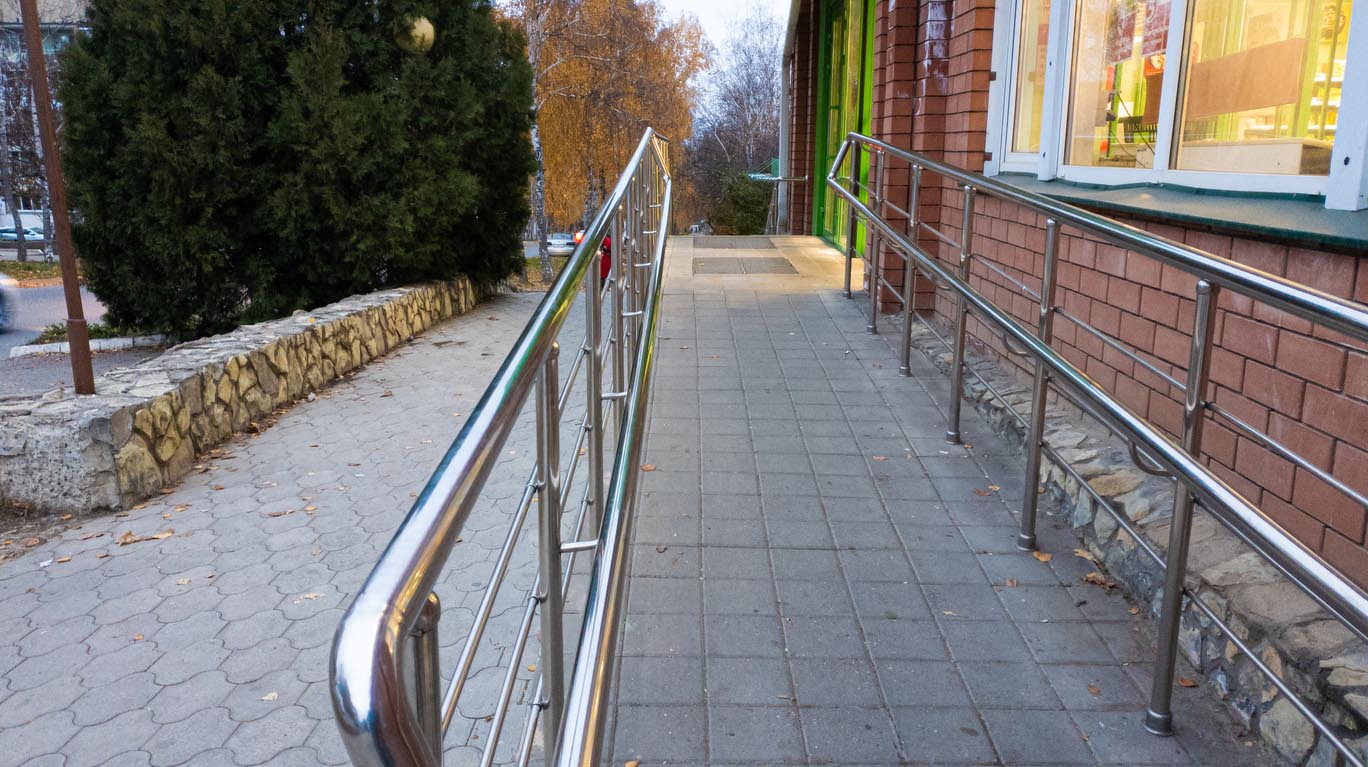
Types of Wheelchair Ramps
There are several wheelchair ramp types to choose from when homeowners are planning this installation project, including custom, mini, modular, permanent, portable, semi-permanent, and threshold ramps. To ensure that the ramp accomplishes the intended purpose, homeowners will want to learn more about the various wheelchair ramp options and select the best wheelchair ramp type for the home.
| Wheelchair Ramp Type | Average Cost (Materials and Labor) |
| Custom | $1,000 to $6,000 |
| Mini | $100 to $200 |
| Modular | $400 to $5,000 |
| Permanent | $1,000 to $6,000 |
| Portable | $100 to $2,000 (ramp only) |
| Semi-permanent | $350 to $2,000 |
| Threshold | $50 to $1,300 |
Custom
A custom ramp can be a great option for individuals with a bit of extra room in the budget. Typically, a custom ramp is built on-site by a professional contractor and crew. It is permanently anchored into the ground, providing ongoing access to the property. Custom ramps are frequently seen outside commercial, industrial, and institutional buildings to increase accessibility.
Custom ramps for the home can be personalized and designed to suit the needs of the household. Homeowners will want to choose an appropriate material, like concrete, steel, or aluminum, then work with the contractor to determine the number of runs, turns, and landings that will be required for the job. Homeowners can plan to spend between $1,000 to $6,000 for the installation of a custom wheelchair ramp.
Mini
Even a single step can create a significant barrier to wheelchair.users, so it’s important for homeowners to have a ramp to help accommodate guests and residents. Mini ramps are the most affordable option available, ranging from just $100 to $200. This type of ramp is generally used on single-stair steps and raised thresholds to provide a simple slope for wheelchair users to ascend or descend.
Mini ramps are easy to build, maneuver, and transport, making them a good choice to take on vacation or to pack when visiting friends or family. There are even adjustable wheelchair ramp options that can be raised or lowered depending on the height of the step or doorway threshold.
Modular
As the name implies, modular wheelchair ramps come in prefabricated modular pieces that are transported to the home and assembled on-site. Modular wheelchair ramps can be ordered through the manufacturer, or the homeowner may be able to purchase a modular wheelchair ramp through the installation company.
After the modular ramp is ordered, it generally takes a long time for the manufacturer to make the ramp and ship the pieces to the address, so it’s a good idea for the homeowner to work with the installer to determine the best time to build the wheelchair ramp. Homeowners who like the concept of a modular wheelchair ramp can expect to pay about $400 to $5,000 for this option.
Permanent
Permanent wheelchair ramps are one of the most costly options, but the ramps also tend to last the longest due to the material and design. Common materials for a permanent wheelchair ramp include concrete, steel, wood, composite, and aluminum. Concrete is frequently used to build highly durable wheelchair-accessible ramps for schools and businesses, but a solid wood ramp with appropriate weatherproofing or a thick, steel ramp can also be used for permanent installations.
The drawback to permanent wheelchair ramps is that they cannot be removed without significant effort, and the removal may damage the building or alter the appearance of the structure itself. Additionally, permanent wheelchair ramps are one of the more costly choices, ranging from $1,000 to $6,000, on average.
Portable
A portable wheelchair ramp is a common choice for vehicles because it can be loaded up into the vehicle and transported between destinations. However, homeowners can also rent or buy portable wheelchair ramps for the home, including track, roll-up, and folding wheelchair ramps. Typically, a portable wheelchair-accessible ramp will cost about $100 to $2,000, making it a cheap home upgrade to help those aging in place.
Homeowners will just want to keep in mind that these products generally have a limited length and low weight restrictions, so it’s best to avoid driving full electric scooters over these ramps. The cost of the ramp can increase or decrease depending on the specific design. Homeowners can consider the following portable ramp options for the vehicle or the home.
| Portable Ramp Option | Average Cost (Materials and Labor) |
| Folding | $100 to $1,000 |
| Roll-up | $300 to $1,300 |
| Track | $250 to $2,000 |
Semi-Permanent
Not every individual owns their home, so it’s important for homeowners to consider installation options that can be added or removed without permanently altering or causing damage to the property. Semi-permanent ramps provide a similar level of support as permanent ramps, but they are not anchored to the ground, allowing the ramp to be removed.
This type of ramp is a good choice for anyone who rents a house or a portion of a house, because the ramp increases accessibility, safety, user independence, and privacy. Semi-permanent wheelchair ramp installation will generally cost about $350 to $2,000, on average.
Threshold
The threshold of the home often has a single step leading up to the doorway. This step can be a significant problem for wheelchair users, which is why many companies manufacture and market threshold ramps. These small, short ramps are typically made of aluminum or rubber.and are used to help wheelchair users enter and exit locations with a raised threshold.
Inexpensive threshold ramps may cost as little as $50, while threshold ramps made with premium materials, such as steel or concrete, can cost as much as $1,300. Homeowners will want to consider the needs of the wheelchair.user before deciding on the right threshold ramp to help enter and exit the home.
Benefits of Wheelchair Ramp Installation
Installing a wheelchair ramp for the home or investing in a portable wheelchair ramp for an RV, van, truck, or any other type of suitable vehicle helps to improve accessibility. Additionally, instead of requiring frequent aid, wheelchair users can take advantage of wheelchair ramps to regain independence and personal privacy. Homeowners can consider the following key benefits of a wheelchair ramp installation.
Accessibility
The primary reason for installing a wheelchair ramp or purchasing a portable wheelchair ramp is to provide access to an area that is otherwise inaccessible to wheelchair users. This can be as simple as setting up a portable wheelchair ramp to enter or exit a vehicle or as complex as building a permanent concrete wheelchair ramp to provide access to the home.
Even if there aren’t any wheelchair users living at the house, a wheelchair ramp can be a good option to increase the accessibility of the home to friends, family, and other guests who may require a ramp to enter and exit the house. Short-term ramp rentals can be an inexpensive alternative to purchasing a wheelchair ramp if the ramp will be used only for a few weeks to a few months.
Independence
A common problem with traditional home designs is that the entrance to the house is often located at the top of a set of stairs. Even those homes that don’t have raised porches will typically have a single step at the threshold of the door, which can prevent wheelchair users from entering or exiting the home.
When the wheelchair user is not free to move inside or outside the home without aid, this impediment can take a toll on their independence. Installing a wheelchair ramp allows wheelchair users to freely leave the house, increasing the amount of personal independence and improving the quality of their lives. Similarly, a portable wheelchair ramp helps wheelchair users access vehicles, so they can go out to take care of daily tasks, such as grocery shopping, without requiring additional aid. Finally, adding a wheelchair ramp is often one of the top aging-in-place design tips to help older adults remain in their own home.
Privacy
Privacy and independence are highly valued by most people, so it will come as no surprise that it can be embarrassing and frustrating to constantly require help to get into the bathroom and shower area. It’s a good idea to have bathroom and bedroom doors widened to ensure that the wheelchair can fit without getting stuck or having to adjust the angle of entrance.
Installing wheelchair ramps inside and outside the home makes it easier for wheelchair users to get around. A mini wheelchair ramp at the entrance to the shower can greatly improve the accessibility to the bathroom, allowing wheelchair users to navigate into the shower without anyone impeding on their privacy.
Safety
The goal of a wheelchair ramp is to help wheelchair users move around inside and outside the home. However, the ramp needs to be built with quality materials by an experienced individual to ensure that it is safe to use. Wheelchair ramps that are built according to ADA guidelines aid wheelchair users in safely navigating potentially hazardous situations, like rain, sleet, snow, or ice.
Additionally, a home that does not have a wheelchair ramp can act as a trap in emergencies. Suddenly, wheelchair users are stuck inside the home, unable to leave without aid. If there is a fire, flood, gas leak, or any other emergency at the property, it’s imperative that there is a wheelchair-accessible ramp so the wheelchair user can flee the premises, if necessary.
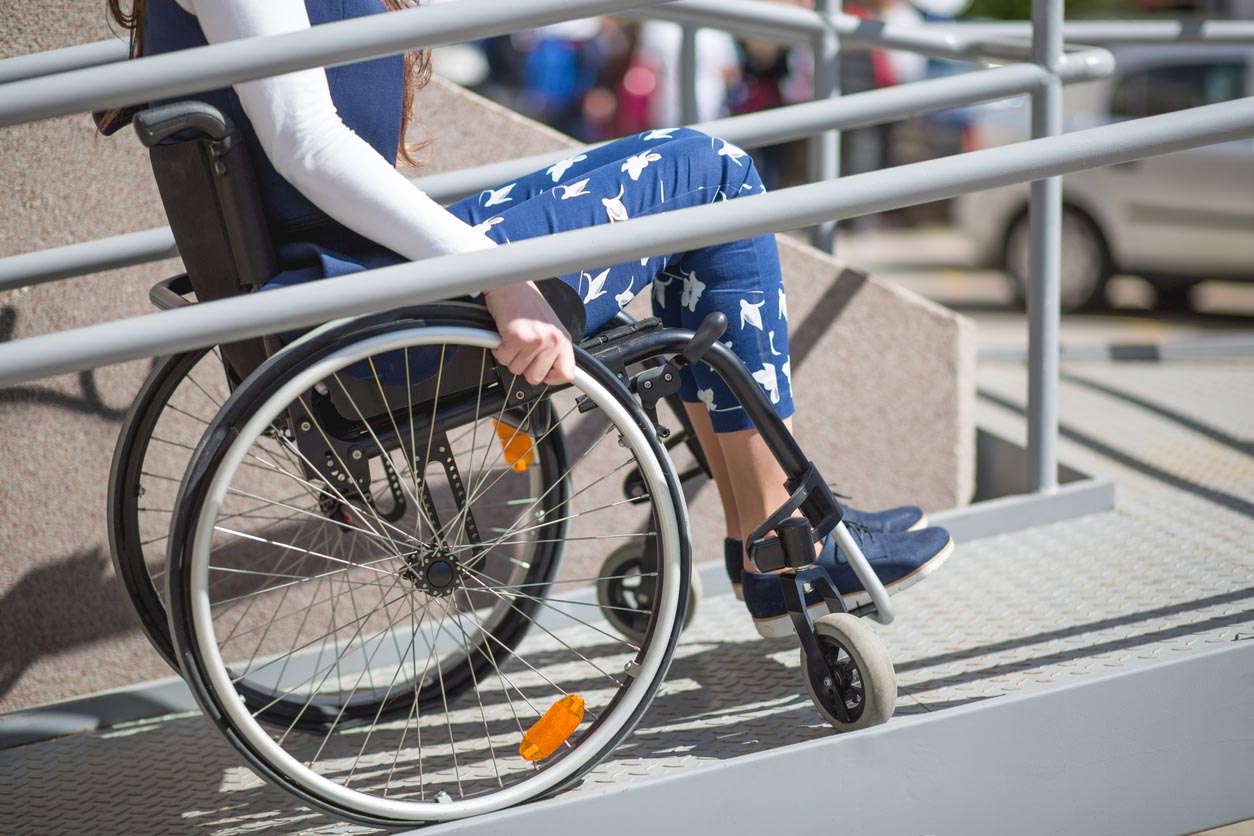
Wheelchair Ramp Installation: DIY vs. Hiring a Professional
Building a wheelchair ramp may seem like a relatively simple project. After all, many people have attempted to build ramps for bikes, rollerblades, or skateboards as kids. However, it isn’t a good idea to take this job on as a DIY project. A wheelchair ramp installation project needs to follow specific guidelines set out by the ADA to ensure that the ramp is safe for use. That’s why it’s recommended that homeowners find one of the best home renovation contractors to complete their wheelchair ramp project.
If the wheelchair ramp is not built according to these guidelines, it can lead to serious injury if the ramp bends, buckles, or completely collapses. Similarly, if the ramp is too narrow, too slippery, or too steep, then the wheelchair.user may not be able to safely ascend or descend the ramp.
Instead, it’s better to hire a crew of trained professionals who know how to build a wheelchair ramp through previous experience. Not only will this help ensure that the ramp is built properly, but many installation companies will also provide a warranty or a product guarantee, so if anything goes wrong with the construction, the homeowner is not held responsible. Homeowners who are saving for other accessibility projects, such as the cost to install a walk-in tub, can use the same crew to complete these home improvements as well.
How to Save Money on Wheelchair Ramp Cost
A wheelchair ramp is an excellent investment to help ensure that the home is accessible to wheelchair users. However, it can cost between $1,031 and $3,313 to have a wheelchair ramp installed, so homeowners may want to come up with a few ways to help save money on the cost of this home renovation project, such as the following.
- Discuss reimbursement with the insurance provider. Speak to your health insurance or home insurance provider to determine if the company will reimburse the cost of a wheelchair ramp installation (not all insurance providers will cover this cost).
- Apply for state-based assistance. Veterans, as well as the elderly and disabled, may be able to get state-based financial assistance to help pay for the installation of one or more wheelchair ramps inside or outside the home.
- Look into nonprofit assistance programs. Even if state-based assistance is unavailable, there are many nonprofit programs that can help provide financial assistance for wheelchair ramp installations.
- Get estimates from several installation companies. Make sure to research and get quotes from at least three reputable companies in the area. This will help ensure that you are getting the best rate for the work.
- Consider renting a ramp for short-term use. If the wheelchair ramp is needed only for a short period of time, then it may be more cost-effective to rent a ramp for the necessary duration.
Questions to Ask About Wheelchair Ramp Installation
Wheelchair ramp installation isn’t a common project, and most homes do not have or require wheelchair ramps, so it can be difficult to determine what exactly is involved with a wheelchair ramp installation. Before homeowners hire a contractor to install the wheelchair ramp, it’s important for them to find out as much as possible about the company, installer, installation process, materials, products, past projects, references, and costs. After searching online for “contractors near me,” homeowners can ask some or all of the following questions to help them feel confident about the installation project.
- Are you and your workers licensed, bonded, and insured?
- Are background checks conducted on all workers?
- How long has the company been in business?
- Do you have any available references?
- Can I see your past project portfolio?
- Which products and brands do you offer?
- Will you install all necessary equipment?
- Can I get a written estimate?
- Will insurance cover the cost of the ramp?
- How long will the installation take?
- Do you need to enter the home?
- What precautions will you take to avoid damaging the home?
- Will you clean up after the work is complete?
- Do you offer a warranty or a product guarantee?
- Do you work closely with state-based or nonprofit assistance programs?
- Will you follow ADA guidelines?
- What type of wheelchair ramp do you suggest?
- Will you get permits for this work?
FAQs
Learning about wheelchair ramp assembly, construction, and costs is a good idea to allow homeowners to better prepare for a wheelchair ramp installation project. The following answers to some of the most frequently asked questions can help homeowners learn more about wheelchair ramp installation.
Q. What is a good material for a wheelchair ramp?
There are several options to choose from when it comes to selecting a base material for the wheelchair ramp. Top choices include wood, steel, composite, and aluminum, though the best option for a permanent wheelchair ramp is concrete.
Q. What size ramp do I need for a wheelchair?
The size of the ramp is dependent on the size of the assistance device and the height of the entrance. ADA guidelines state that the ramp must be a minimum of 36 inches wide by 60 inches in length, but the size can increase to better accommodate more accessible designs.
Q. Will health insurance cover wheelchair ramps?
Some insurance providers may fully or partially cover the cost of wheelchair ramp installation, though it often depends on the health requirements of the individual. Speak to your insurance provider to determine if the company will help cover the cost of the wheelchair ramp installation.
Q. How wide is a wheelchair ramp?
The width of the ramp is dependent on the size of the assistance device and the height of the entrance. The ramp needs to be wide enough for the wheelchair or scooter to ascend, descend, and turn corners without difficulty. The ADA recommends that the ramp stand at a minimum of 36 inches in width by 60 inches in length, though the size can be increased depending on the design.
Q. Do I need a permit to build a wheelchair ramp?
Most mini, portable, and threshold wheelchair ramps can be set up without a permit. Some semi-permanent and modular ramps can also be installed without a permit. However, custom, permanent, and some semi-permanent wheelchair ramps will require a permit, so it’s a good idea to speak to the local permit office to determine if a permit is necessary before beginning the project.
Q. Can you rent a wheelchair ramp?
When a family member, friend, or another guest who requires a wheelchair is coming to stay for a few days to a few months, it can be a cost-effective idea to rent a wheelchair ramp on a monthly basis. Just keep in mind that there will be an initial onetime installation fee on top of the rental monthly fee for this service.
Sources: Angi, HomeAdvisor, Fixr

